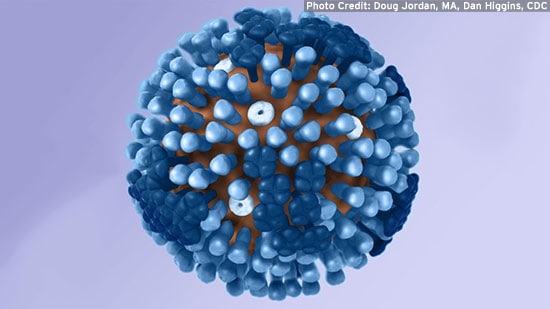
Pandemic Flu
What is Pandemic Flu?
A flu pandemic is a global outbreak of influenza caused by a new influenza virus. Pandemics occur when new strains of the influenza virus, often from avian or porcine sources infect people. For a pandemic to be declared, the new influenza virus subtype must emerge for which there is little or no immunity. In addition, it must infect humans and cause illness and spread easily and continue without interruption among humans. These new influenza viruses strains can spread quickly because most people will not be immune to the new virus strain and a vaccine might not be widely available to offer immediate protection. Given the growth of global travel, a pandemic can spread rapidly and globally giving countries and regions little time to prepare a public health response.
Influenza pandemics are rare with four being recorded in the past 100 years - 1918, 1957, 1968 and 2009. Past influenza pandemics have been caused by Influenza A viruses, strains H1N1, H2N2 and H3N2. past pandemics
Virus often infect only one species or group of animals and do not efficiently infect other animals. Periodically, a virus may mutate to a form that is readily transmitted from human to human. The two most likely routes that could result in the transfer between unrelated animals are:
- Antigenic Drift: The virus goes through several point mutations and acquires the ability to infect humans AND transfer efficiently from human to human. This is thought to be what happened in 1918.
- Antigenic Shift: A mammalian host (human or pig) becomes infected with both a common human flu strain and a virulent avian flu strain. The two viruses combine in the pig to form a new virus with the virulence of the bird strain and the ability to pass from human to human. This occurred in the pandemics of 1957 and 1968. This re-assortment could also occur in humans, which is why it is very important that sick individuals avoid contact with birds.
The World Health Organization (WHO) closely monitors the emergence of new strains, such as influenza A strains H1N1 and H7N9.
Phases of Pandemic Influenza
The WHO classifies the global stages associated with a pandemic alert. The phases reflect the WHO’s risk assessment of the global situation regarding each influenza virus with pandemic potential infecting humans. The phases provide a high-level, global view of the evolving picture. The four phases of a pandemic are interpandemic, alert, pandemic and transition.
Interpandemic phase: This is the period between influenza pandemics.
Alert phase: This is the phase when influenza caused by a new subtype has been identified in humans. Increased vigilance and careful risk assessment, at local, national and global levels, are characteristic of this phase. If the risk assessments indicate that the new virus is not developing into a pandemic strain, a de-escalation of activities towards those in the interpandemic phase may occur.
Pandemic phase: This is the period of global spread of human influenza caused by a new subtype based on global surveillance. Movement between the interpandemic, alert and pandemic phases may occur quickly or gradually as indicated by the global risk assessment, principally based on virological, epidemiological and clinical data.
Transition phase: As the assessed global risk reduces, de-escalation of global actions may occur, and reduction in response activities or movement towards recovery actions by countries may be appropriate, according to their own risk assessments. pandemic flu risk management
A pandemic can cause a large number of illnesses and deaths, drastic disruption of critical services, and severe economic losses. Once a strain emerges, there may be little time between the onset of a pandemic and its spread around the globe, with outbreaks occurring simultaneously in many areas. The impact could last for weeks to months. National public health officials work closely with WHO to develop plans and have Web sites specific to their public needs (see references).
In 2009, a new strain of H1N1 Influenza, originally from pigs, acquired the ability to be transmitted among humans. However, contact with pigs was not associated with ongoing transmission in the 2009 influenza pandemic. More information on the H1N1 pandemic influenza can be found here. CDC pandemic flu resources
REFERENCES AND FURTHER INFORMATION
- World Health Organisation pandemic preparedness http://www.who.int/influenza/preparedness/pandemic/en/
- World Health Organisation pandemic influenza risk management http://www.who.int/influenza/preparedness/pandemic/influenza_risk_management_update2017/en/
- European Union influenza pandemic planning information https://ecdc.europa.eu/en/seasonal-influenza/preparedness/influenza-pandemic-preparedness-plans
- U.S. CDC national pandemic influenza plans https://www.cdc.gov/flu/pandemic-resources/planning-preparedness/national-strategy-planning.html
- Center for Infectious Disease Research and Policy http://www.cidrap.umn.edu/infectious-disease-topics/pandemic-influenza


